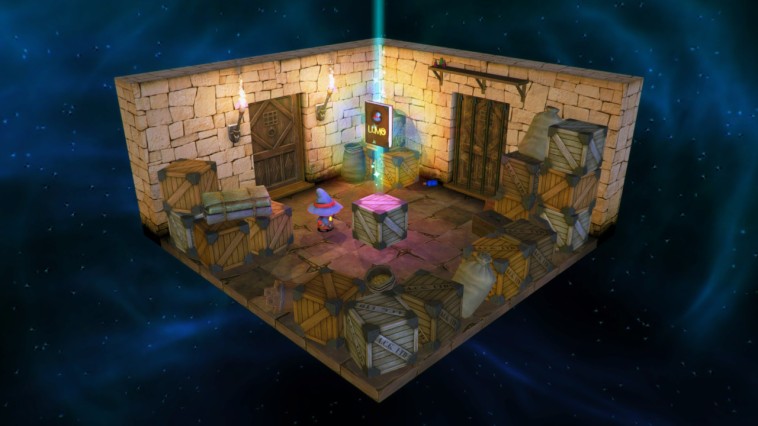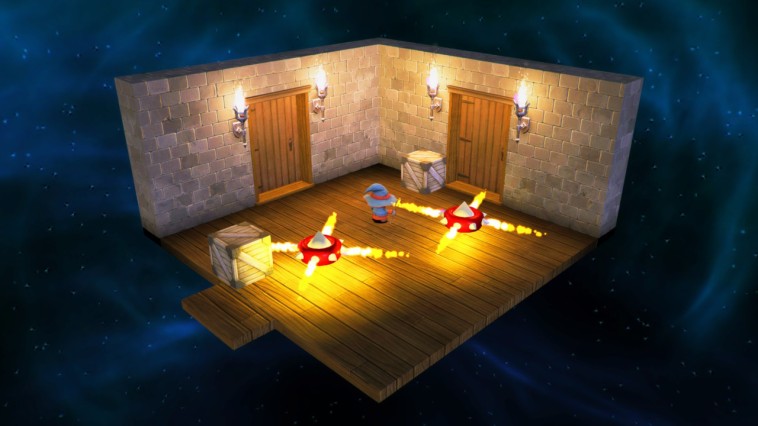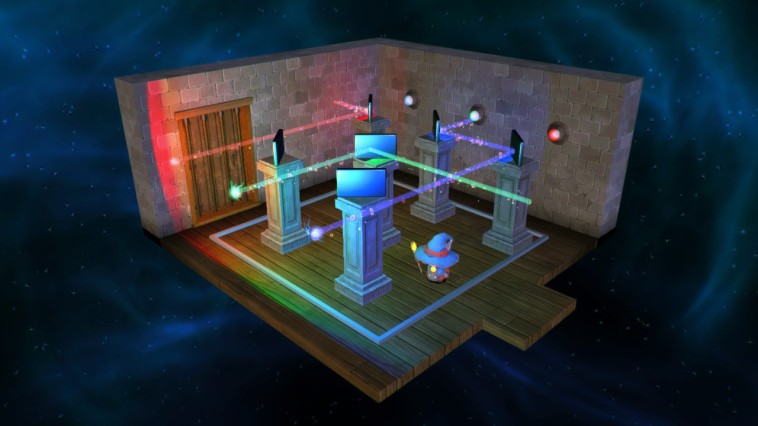
In the effort to help capture the “retro” effect of many games of the past, some developers have kind of missed out on what made those games incredible. Sure, Volgarr the Viking did a spot on job of capturing some of the simplicity that made those titles great, and Retro City Rampage really takes the classic effects and shows how grand such ideas can be with a little implementation. But very few of them fully capture a particular vibe and, instead, you get an overall “classic” feel without a particular focus. It’s not a bad thing, but it’s an observation that many of these games simply capture the grand idea and not a specific idea.
Lumo is the answer to all of that. With a plot as simple as “child gets sucked into arcade cabinet” to inspire you, you end up with a game that is a spit-polished spiritual successor to a forgotten NES classic, Solstice. Solstice was an amazing isometric puzzle game that meant solving rooms one at a time, sometimes backtracking in order to find new elements or trigger faraway switches in order to access what comes next. Lumo, in comparison, does all of those things but in a weirdly 2.5D way that brings about a whole new meaning to the idea of a retro puzzler.
Let me slow down. First and foremost, the developers of Lumo (Triple Eh? studios) have absolutely zero inhibitions about what they’re doing. They set out to make a game that was a reference to older titles and they positively kill it. You’re given a choice of how you’d like to play (old school or new school), can decide and test out your joystick orientation and then set you free with no other instructions whatsoever. It’s up to the player to pay attention and figure out what to do, because the most powerful thing you’ll find in this game is the ability to jump and that’s really it. Sure, you look like a wizard, but this isn’t your daddy’s magical game. This is your grandfather’s video game, where the most amazing thing was making sure the code ran on the 16KB of RAM that you paid hundreds of dollars to have installed.

There’s nothing random or surprising about Lumo once you get going. If you choose the old school route, you only have three deaths before it’s game over, and you quickly realize that the game is static: every room you run into is going to be in the same place every single time. Again, I’m a huge fan of roguelike titles, so it was a little jarring to realize that the flaming traps and spikes of pain would always be exactly where I imagined them. As a result, players might be inclined to try a couple of different playthroughs. The first would be to focus on simply beating the game (average time is under 3 hours) and the second is to see how many of the goodies you can collect. There are rubber ducks (almost always in perilous spots), cassette tapes (often out of the way) and other surprises that I won’t completely spoil. Lumo has a surprising about of content to it for a game that, on the surface, just seems to be “get out of here.”
Once you get the hang of navigation, you’ll still find yourself pissed a lot at the game’s design. Since it’s a slightly askew vantage point, there are corners and parts of the rooms that you cannot see whatsoever. Most of the time, this isn’t a problem, but there are a few moments where you might not see the trap or collectible that’s just beyond your scope of vision until it’s too late. There’s a little bit of give as far as camera rotation but it’s barely worth mentioning: it’s almost like the game is taunting you to suggest it’s possible to move the camera but, no, we’re not gonna. Players are going to find themselves wishing they could rotate just slightly more to see if there’s another way to perform a task, but, by and large, everything is still doable.
I really enjoyed the 2.5D graphics that Lumo decided upon. It gives a distinctly retro-future feeling to everything, and I think it helps make the rooms pop and the adventure just a bit more enjoyable as a result. The lack of actions that a player can take in their quest for glory is a bit disheartening, so it’s nice to see a particular interest taken in how the game looks and performs. Still, despite the round, 3D objects, this isn’t a hard-hitter in terms of system intensity for the Switch. Don’t anticipate slowdowns, frame drops or load times to be an issue: Lumo, for everything else, is smooth as butter.

Lastly, the soundtrack. I’ve been straying further and further from paying attention to a game’s music recently, and, with the exception of XONiC, haven’t really even thought about a game’s tunage longer than it takes to play through a level. Lumo, for whatever reason, put an enormous amount of care to try and get music that best matched the intended atmosphere for what was going on. Again, trying to imagine the situation of someone who’s alive in the early 90s but been transported into a game that’s clearly from the 70s. The result is this ambient, restless sort of synthwave that actually sits incredibly well in each and every room. Far from being a wasted opportunity with fake “fantasy” type notes, Lumo delivers tension and interest in every section, delivering a further take upon what the intent was in creating this game. I highly recommend giving it a listen as soon as possible, it’s gorgeous.
Lumo isn’t quite what I wanted it to be. I mean, don’t get me wrong, it delivered on every level what it promised, but I was hoping it would also recapture some of the wonder and excellence that games of the time gave me in younger days. Far from creating a sensation of replay and satisfaction, however, it just kind of made me yearn for a time when this was the entirety of what gaming could be. But the graphics and the design, combined with the purposely hamstrung controls, reminded me that more IS possible nowadays, and retro gaming is a field of go big or go home. Lumo feels like it quietly fell in the middle, and my frustration at some rooms wasn’t a “wow, old games were hard!” sort of feeling, but a “why did they make this room like this?” almost whine. Lumo has it’s fans, and old school enthusiasts who have a flair for the modern will find a great deal of interest here (not to mention a kickass soundtrack). But, as for me, I’m going to give my tired fingers a rest and, perhaps later, revisit this particular machination.

REVIEW CODE: A complimentary Nintendo Switch code was provided to Bonus Stage for this review. Please send all review code enquiries to press@4gn.co.uk.
Subscribe to our mailing list
Get the latest game reviews, news, features, and more straight to your inbox
Thank you for subscribing to Bonus Stage.
Something went wrong.
-
Gameplay - /10
0/10
-
Graphics - /10
0/10
-
Sound - /10
0/10
-
Replay Value - /10
0/10





